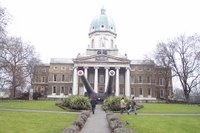Imperial War Museum
Visited the Imperial War Museum yesterday, before almost passing out. If you like war, imperialism, and museums, accept no substitute.
 This is the entrance of the IWM. The left gun is from HMS Ramillies, and the right from HMS Resolution. The British 15″ was one of the finest weapons ever installed on a battleship, and it’s pretty nifty to see a pair of them together, in turret style. The gun on the right was also installed on the monitor HMS Roberts, which provided shore bombardment on D-Day.
This is the entrance of the IWM. The left gun is from HMS Ramillies, and the right from HMS Resolution. The British 15″ was one of the finest weapons ever installed on a battleship, and it’s pretty nifty to see a pair of them together, in turret style. The gun on the right was also installed on the monitor HMS Roberts, which provided shore bombardment on D-Day.
The main hall on the first floor of the IWM contains artifacts from various 20th  century British wars. They have about half a dozen tanks, plus armored cars, artillery pieces, and aircraft. The weapon come from both British and foreign stocks. This is a T-34/85, probably the finest all-around tank of World War II. The 85mm gun was big enough to kill even the heaviest German tanks, assuming you could hit them in the right place. The T-34 was the best tank not because it was the fastest, or the best armored, or the hardest hitting. Rather, it had good tank qualities, good survivability, was very easy to mass produce, and very easy to repair. The Soviets realized early on that a tank with a battlefield life expectancy of 3 weeks did not require an engine that could last for 5 years. They also realized that tanks that could move from battlefield to battlefield on their own power, rather than on railcars, were valuable. The T-34 could also take a hit, which differentiated it from the American Shermans.
century British wars. They have about half a dozen tanks, plus armored cars, artillery pieces, and aircraft. The weapon come from both British and foreign stocks. This is a T-34/85, probably the finest all-around tank of World War II. The 85mm gun was big enough to kill even the heaviest German tanks, assuming you could hit them in the right place. The T-34 was the best tank not because it was the fastest, or the best armored, or the hardest hitting. Rather, it had good tank qualities, good survivability, was very easy to mass produce, and very easy to repair. The Soviets realized early on that a tank with a battlefield life expectancy of 3 weeks did not require an engine that could last for 5 years. They also realized that tanks that could move from battlefield to battlefield on their own power, rather than on railcars, were valuable. The T-34 could also take a hit, which differentiated it from the American Shermans.
The Lawrence of Arabia exhibit cost extra, and I didn’t have a lot of time, so I missed it. The best of the other exhibits was the extensive reproduction of a World War I British trench system. The WWI and WWII exhibits were quite extensive, although a bit more general than I had hoped. It was nice to see a lot of kids there, though. There are also some exhibits dedicated to post-WWII conflicts, including Suez, the Falklands, and Gulf War I. I suppose that there will someday be an exhibit devoted to Gulf War II.
The IWM also maintains the HMS Belfast, a WWII light cruiser. Belfast carried 12 6″  guns, making her a light cruiser in name, if not in fact. After Japan and the United States exhausted their quota of heavy cruisers in the interwar period, they began to compete in light cruiser construction. Heavy cruisers carried 8″ guns; legally, anything carrying lighter guns was, by definition, a light cruiser. The Japanese and Americans responded to this legal environment by building ships that were as large as heavy cruisers, but carried 15(!) 6″ guns. The Belfast and her sisters were the British response, and were generally more balanced ships. Belfast participated in the sinking of the German battlecruiser Scharnhorst on December 26, 1943. The Tower Bridge is in the background.
guns, making her a light cruiser in name, if not in fact. After Japan and the United States exhausted their quota of heavy cruisers in the interwar period, they began to compete in light cruiser construction. Heavy cruisers carried 8″ guns; legally, anything carrying lighter guns was, by definition, a light cruiser. The Japanese and Americans responded to this legal environment by building ships that were as large as heavy cruisers, but carried 15(!) 6″ guns. The Belfast and her sisters were the British response, and were generally more balanced ships. Belfast participated in the sinking of the German battlecruiser Scharnhorst on December 26, 1943. The Tower Bridge is in the background.
Incidentally, the last of the big American light cruisers was the General Belgrano, transferred to Argentina after World War II. General Belgrano was sunk by a British submarine in the Falklands War.


